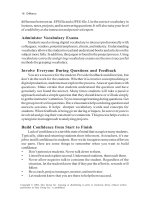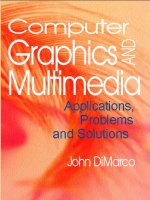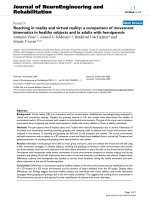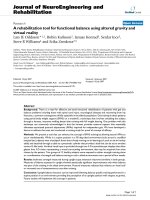Lecture computer graphics and virtual reality slides lesson 7 projection transformation
Bạn đang xem bản rút gọn của tài liệu. Xem và tải ngay bản đầy đủ của tài liệu tại đây (1.51 MB, 33 trang )
Lesson 7
Projection
Transformation
Trinh Thanh Trung School of ICT, HUST
Content
1. 3D viewing and projection
2. Parallel projection
3. Perspective projection
1.
3D viewing and projection
3D viewing
■ Part of the difficulty lies in trying to display three
dimensional objects on a 2D display
■ Different views on the same object eventually
lead to different 2D representations at the
projection stage
□ The projected 2D image of a 3D object is viewer
dependent
■ Different views can be specified based on several
parameters e.g. position, orientation, field of view
3D viewing methods
■ On 2D displays:
□ perspective and depth of field
□ depth cueing
□ visible line/surface identification
□ surface rendering
□ exploded/cutaway scenes, cross-sections
3D viewing
6
3D viewing can be faked?
3D viewing methods (cont.)
■ On 3D display
□ Hologram display
Stereoscopic display
■ Faking depth in a 2D image
■ Based on natural stereoscopic eye-brain system.
■ Objects are not viewed with just one eye, but
two eyes.
■ Each eye looks at the object from a slightly
different location.
Stereoscopic display
Projections transform
points in n-space to
m-space, where m
Projections
■ In 3-D, we map points from 3-space to the
projection plane (PP) (a.k.a., image plane) along
projectors (a.k.a., viewing rays) emanating from
the center of projection (COP):
■ There are two basic types of projections:
□ Perspective – distance from COP to PP finite
□ Parallel – distance from COP to PP infinite
2.
Parallel projection
Parallel projection
■ Parallel projection is the projection which the
projection lines are parallel or start from infinity
■ Points on the object are projected to the viewing
plane along parallel lines
■ Preserves relative dimensions of the object but
does not give a realistic presentation
A’ A
B
D’
B’
centre of D
projection at
C
infinity C’
projection
plane
Parallel projection properties
■ Are actually a kind of affine transformation
□ Parallel lines remain parallel
□ Ratios are preserved
□ Angles not (in general) preserved
■ Not realistic looking
■ Good for exact measurements
Most often used in
▫ CAD,
▫ architectural drawings,
▫ etc.,
where taking exact measurement is important
Homogeneous transform
■ For projections, we specify a direction of
projection (DOP) instead of a COP.
■ We can write orthographic projection onto the
z=0 plane with a simple matrix, such that x’=x, y’=y.
x
x ' 1 0 0 0
y ' = 0 1 0 0 y
z
1 0 0 0 1
1
Orthographic projection
■ Orthographic projection is a form of parallel
projection which all the projection lines are
orthogonal to the projection plane
Orthographic projection
■ For each projection plane we have a
corresponding transformation matrix
1 0 0 0 0 0 0 0 1 0 0 0
[Ty ] = 0 0 0 0 [Tx ] = 0 1 0 0 [Tz ] = 0 1 0 0
0 0 1 0 0 0 1 0 0 0 0 0
0 0 0 1
0 0 0 1 0 0 0 1
Axonometric projection
■ Axonometric projection
is a type of orthographic
projection, where the lines
of sight are perpendicular
to the plane of projection,
and the object is rotated
around one or more of its
axes to reveal multiple
sides.
Axonometric projection
Isometric
■ Three axes of space appear equally foreshortened
(~120°)
■ Corresponding rotating angles are 35.26° and 45°
2 1 − 2 sin2
sin =
1 − sin 2
f = cos2 = 2 / 3 = 0.8165
2 sin2
sin =
1 − sin 2
2sin = sin2 1/3
2= =1/2
1 − sin 1 −1 /3
sin = 1
3






![mathematical foundations of scientific visualization, computer graphics, and massive data exploration [electronic resource]](https://media.store123doc.com/images/document/14/y/up/medium_upb1401358803.jpg)


